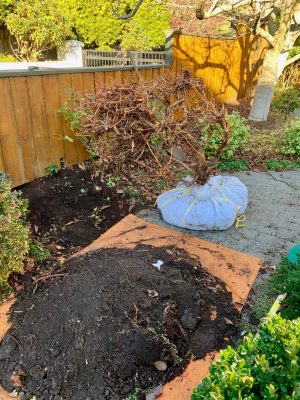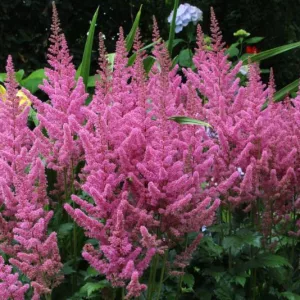I often get asked how to move trees and shrubs. Here is some information to help you with that task.
There are two appropriate timeframes for transplanting small trees and shrubs: plants are dormant in mid fall or in early spring before new growth begins. If you chose fall, changing leaves are a sign that the plants are shutting down for the winter and transplanting can be begin.
When moving a more established tree or shrub, doing some root pruning first will increase your chance of success. Trace a circle in the soil as wide as you can dig. Divide the circle into four even quadrants. Take a sharp spade and slice down through the roots on two of the four quadrants that are opposite each other. Make note of where you have cut the roots. Next spring cut down and sever the roots in the last two areas. Next fall you will be ready to move the plant.
This method of root pruning forces the plant to develop new fibrous roots within the area you intend to dig. These roots will nourish the plant until it is time to transplant. Also, the new roots will make the plant easier to move as a firm rootball will be established. By doing half the roots at a time, there is less shock to the tree or shrub.
Whether it’s now or later, once you are ready to transplant, make sure the ground is moist before you start to dig. Have the new planting hole prepared in advance, ensuring it is the same depth as the root ball you are digging. When at all possible, dig the root ball as wide as the foliage extends out.
Have some compost and transplanting food on hand to mix with the existing soil at the new site. Plan to use 2/3 native soil amended with 1/3 compost or planting mix.
Plants grown in clay-based soil will hold together well when dug. If you are moving a plant from a site with sandy, loose soil, have burlap on hand. Dig around the plant with a sharp spade, severing the roots cleanly. Slide the burlap under the rootball on one side. Have a helper tip the plant carefully in the opposite direction so you can push the burlap right under the rootball. Then tip the plant towards you so your helper can pull the burlap through to the other side. Snug the burlap up tight around the entire rootball so that you can move it without the soil collapsing and roots tearing.
Scuff some bone meal into the bottom of the planting hole. Then set your tree or shrub into the ground at the same level that it was previously growing. Back fill 1/3 of the way up the root ball with prepared soil mixed and firm in well.
Loosen the burlap from around the trunk and roll it right down, ensuring it is all tucked below the soil line. There is no need to totally remove the burlap as it will disintegrate over time. At this point, water thoroughly.
One option for helping your plant quickly establish strong new roots is to mix a transplanter solution full of mycorrhizal fungi in your watering can. These beneficial fungi bond to the roots, extend out into the soil, helping plants absorb food and water more efficiently.
If the crown of the tree you have moved is well established, you may need to stake it for two seasons. Stake on either side of the trunk in line with the strongest winds in your area. Attach the trunk to the stake with a tree strap. Alternatively, you can use wire or rope run through a piece of garden hose. For smaller trees, you can use a length of panty hose. It is strong yet supple.
If you have an unfortunate accident and damage the bark of the tree while moving it, apply tree wound dressing to seal the damaged area.




